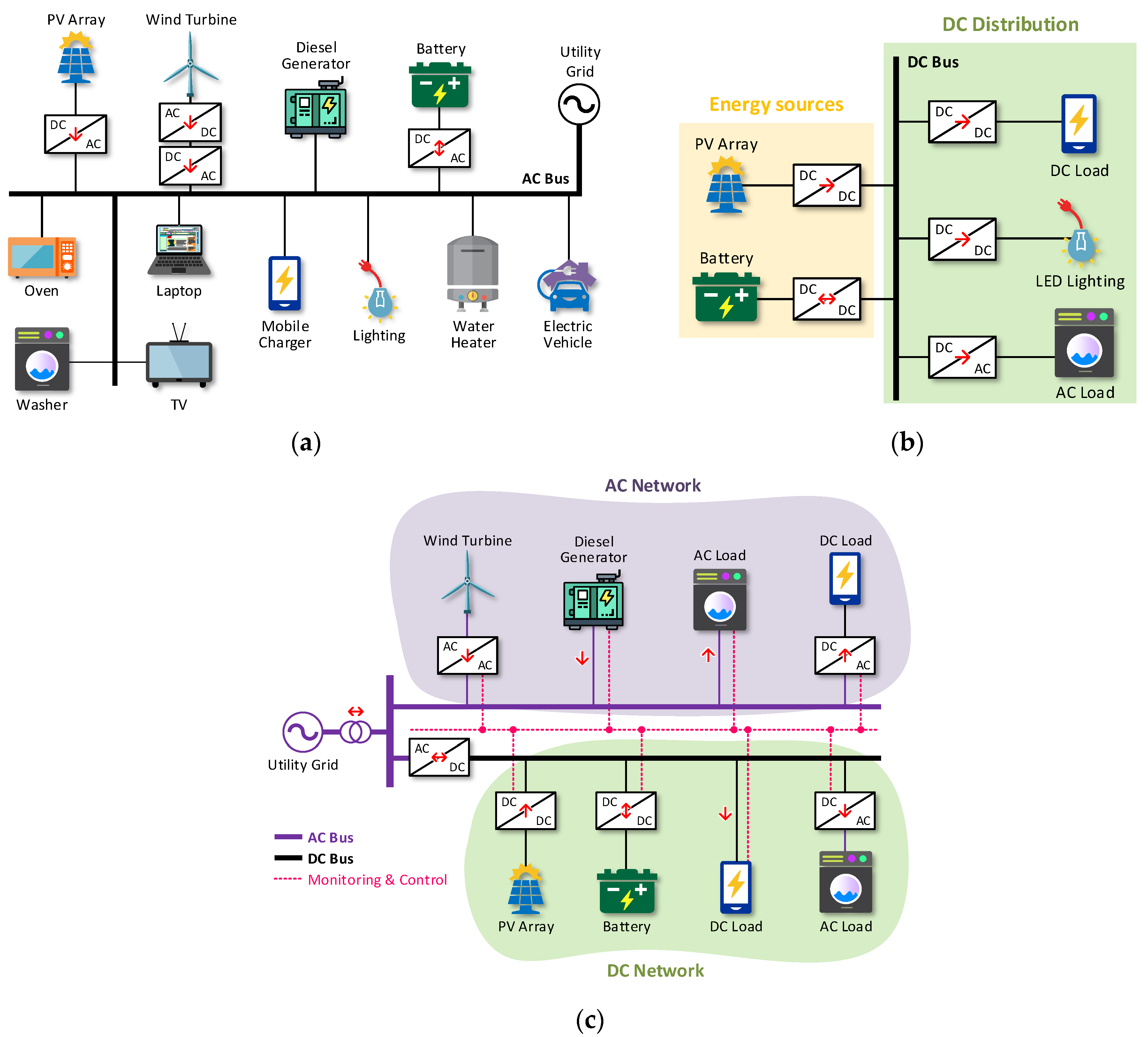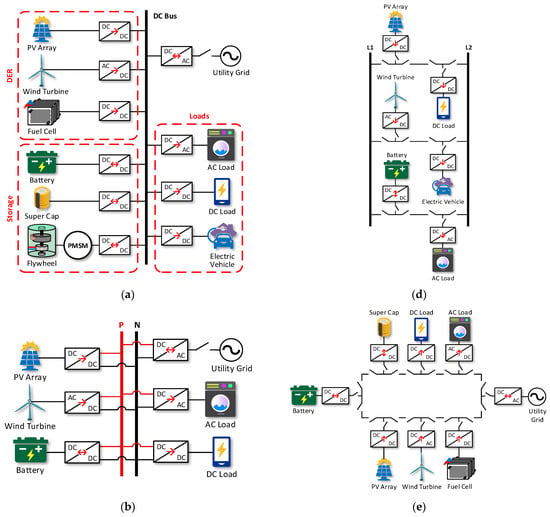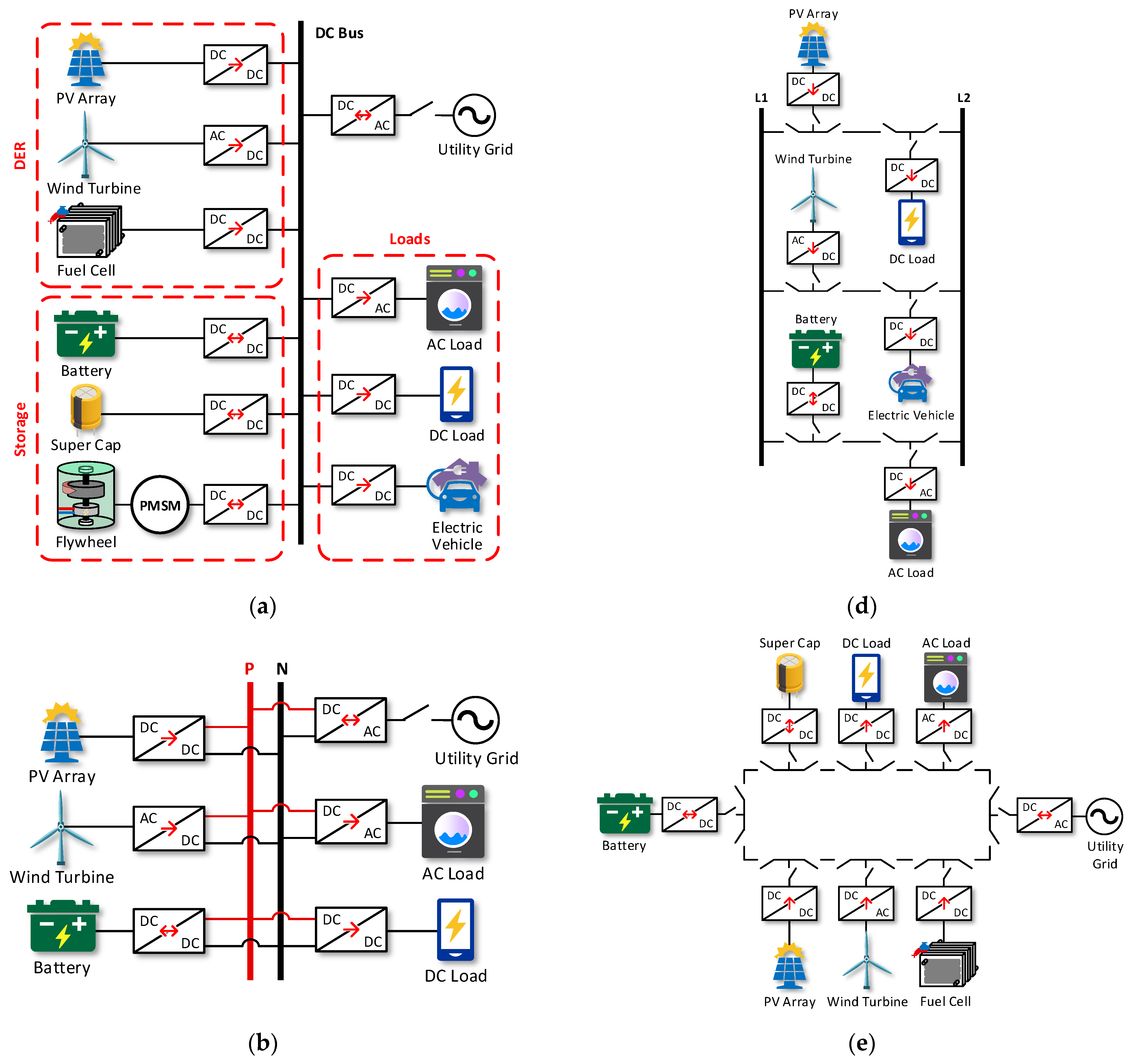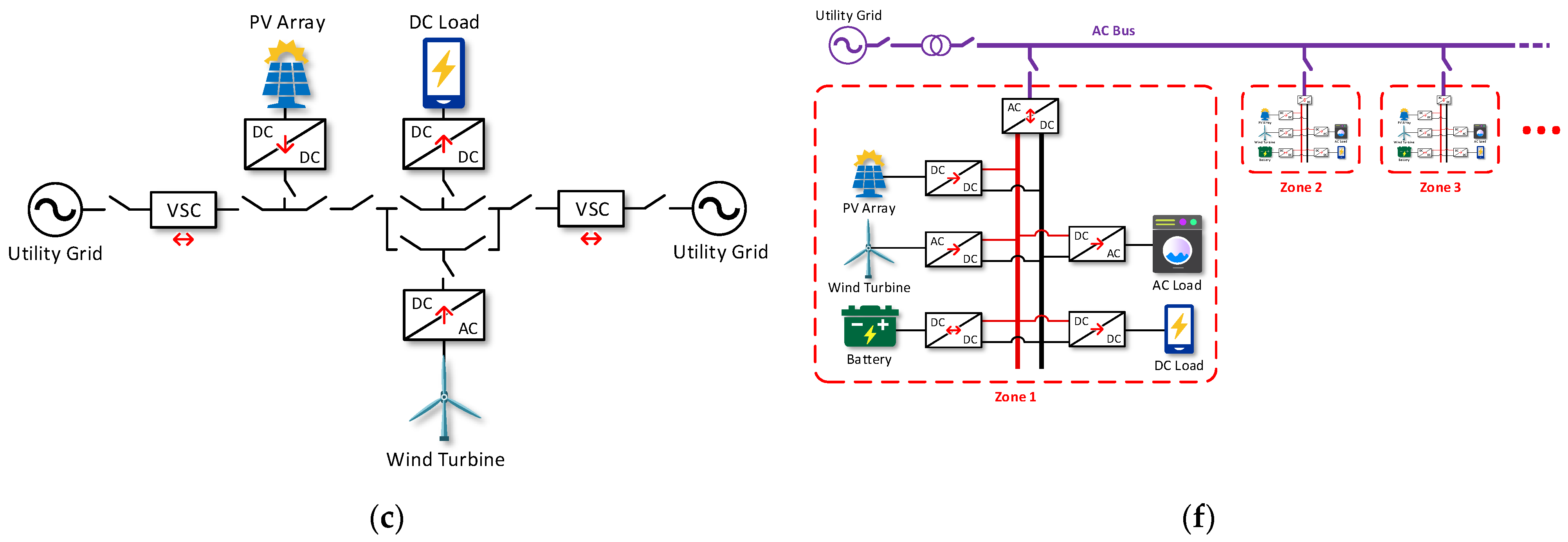Environmental issues and the global need to extend sustainable access to electricity have fostered a huge amount of research in distributed generation by renewables. The challenges posed by the widespread deployment of distributed generation by renewables, such as intermittent power generation, low inertia, the need for energy storage, etc., call for the development of smart grids serving local specific areas or buildings, referred to as microgrids and nanogrids, respectively. This has led in the last decades to the proposal and actual implementation of a wide variety of system architectures and solutions, and along with that the issue of the power converters needed for interfacing the AC grid with DC micro- or nanogrids, and for DC regulation within the latter. This work offers an overview of the state of the art of research and application of nanogrid architectures, control strategies, and power converters topologies.
- nanogrids
- hierarchical control
- grid architectures
- Interfacing power converters
- Control strategies
- Power converters classification
1. Introduction
-
“a single domain for voltage, price, reliability, quality, and administration” [3], where the accent is on power distribution only, functional aspects of the loads are disregarded, and power sources are not part of the NG, which may or may not include BESS but must feature a controller device. In this case, NGs can be also seen as clusters of a MG;
-
“a small power system that uses a combination of renewable and non-renewable energy sources to supply power to small local loads” [4]; here, the accent appears to be more on the size of the system, which is seen as a miniature replica of larger power systems, with its own energy sources, storage, loads, and some controlling entity.
-
local access to some type of DER;
-
use of BESS;
-
connection to the PG (with some islanding capability).
-
DC/AC converters to connect DERs with DC power output such as photovoltaic (PV) plants or fuel cells (FCs), as well as BESS, to AC loads, or when a bi-directional connection of a DC NG to the PG is required;
-
DC/DC converters for intra-NG level shifting to power DC loads of different type and sizes, and for voltage boost in battery charge circuits;
-
AC/DC converters for the point of common coupling (PCC) between the PG and a DC NG, or at the interface between an AC NG and BESS.
2. Nanogrid Architectures
MGs can be classified based on their topology in three major groups, namely, AC, DC, and hybrid [6[6][7],7], as schematically shown in Figure 1. NGs can operate as AC, DC, or hybrid structures, too [5[5][8],8], but they usually have a smaller capacity and serve a smaller area (e.g., a single building or load) [9,10,11][9][10][11].
| Advantages | References | |||
|---|---|---|---|---|
| Energy conversion stages reduction | [15,16] | [15][16] | ||
| Overall efficiency improvement | [6,11,14,15,16,17,19] | [6][11][14][15][16][17][19] | ||
| Reliability improvement | [6,,15,16,17] | [6] | 11 | [11][15][16][17] |
| Absence of reactive power and less losses | [6,11,14,15] | [6][11][14][15] | ||
| Augmented transmit power capability | [6,14,16,19] | [6][14][16][19] | ||
| No electromagnetic interference | [6] | |||
| Complexity reduction | [6,15,16] | [6][15][16] | ||
| No synchronization problems | [6,11,14, | [11][14 | 15] | [6]][15] |
| Control algorithm simplification | [6,15,17] | [6][15][17] |




References
- Boroyevich, D.; Cvetkovic, I.; Burgos, R.; Dong, D. Intergrid: A future electronic energy network? IEEE J. Emerg. Sel. Top. Power Electron. 2013, 1, 127–138.
- Burmester, D.; Rayudu, R.; Seah, W.; Akinyele, D. A review of nanogrid topologies and technologies. Renew. Sustain. Energy Rev. 2017, 67, 760–775.
- Nordman, B.; Christensen, K.; Teleke, S.; Oehlerking, L.; Hong, M. Local power distribution with nanogrids. In Proceedings of the International Green Computing Conference Proceedings, IGCC 2013, Arlington, VA, USA, 27–29 June 2013.
- Teleke, S.; Oehlerking, L.; Hong, M. Nanogrids with energy storage for future electricity grids. In Proceedings of the IEEE PES T&D Conference and Exposition, Chicago, IL, USA, 14–17 April 2014.
- Boroyevich, D.; Cvetković, I.; Dong, D.; Burgos, R.; Wang, F.; Lee, F. Future electronic power distribution systems—A contemplative view. In Proceedings of the International Conference on Optimisation of Electrical and Electronic Equipment, OPTIM, Brasov, Romania, 20–22 May 2010.
- Justo, J.J.; Mwasilu, F.; Lee, J.; Jung, J.W. AC-microgrids versus DC-microgrids with distributed energy resources: A review. Renew. Sustain. Energy Rev. 2013, 24, 387–405.
- Nguyen, M.Y.; Yoon, Y.T. A comparison of microgrid topologies considering both market operations and reliability. Electr. Power Compon. Syst. 2014, 42, 585–594.
- Karabiber, A.; Keles, C.; Kaygusuz, A.; Alagoz, B.B. An approach for the integration of renewable distributed generation in hybrid DC/AC microgrids. Renew. Energy 2013, 52, 251–259.
- Salomonsson, D.; Sannino, A. Low-voltage DC distribution system for commercial power systems with sensitive electronic loads. IEEE Trans. Power Deliv. 2007, 22, 1620–1627.
- Nordman, B.; Christensen, K.; Meier, A. Think globally, distribute power locally: The promise of nanogrids. Computer 2012, 45, 89–91.
- Werth, A.; Kitamura, N.; Tanaka, K. Conceptual study for open energy systems: Distributed energy network using interconnected DC nanogrids. IEEE Trans. Smart Grid 2015, 6, 1621–1630.
- Sulzberger, C.L. Triumph of AC. 2. The battle of the currents. IEEE Power Energy Mag. 2003, 99, 70–73.
- Sulzberger, C.L. Triumph of AC—From Pearl Street to Niagara. IEEE Power Energy Mag. 2003, 1, 64–67.
- Asad, R.; Kazemi, A. A quantitative analysis of effects of transition from AC to DC system, on storage and distribution systems. In Proceedings of the Asia-Pacific Power and Energy Engineering Conference, Shanghai, China, 27–29 March 2012.
- Dragicevic, T.; Vasquez, J.; Guerrero, J.; Škrlec, D. Advanced LVDC electrical power architectures and microgrids. IEEE Electrif. Mag. 2014, 2, 54–65.
- Stippich, A.; Sewergin, A.; Engelmann, G.; Gottschlich, J.; Neubert, M.; van der Broeck, C.; Schülting, P.; Goldbeck, R.; de Doncker, R.W. From Ac to Dc: Demonstration of benefits in household appliances. In Proceedings of the International ETG Congress 2017—Die Energiewende, Bonn, Germany, 28–29 November 2017; pp. 422–427.
- Kumar, R.; Behera, R.K. A Low cost distributed solar DC nanogrid: Design and deployment with remote monitoring unit. In Proceedings of the 20th National Power Systems Conference (NPSC), Tiruchirappalli, India, 14–16 December 2018; pp. 1–6.
- Rodriguez-Diaz, E.; Vasquez, J.C.; Guerrero, J.M. Intelligent DC homes in future sustainable energy systems: When efficiency and intelligence work together. IEEE Consum. Electron. Mag. 2016, 5, 74–80.
- Starke, M.; Li, F.; Tolbert, L.M.; Ozpineci, B. AC vs. DC distribution: Maximum transfer capability. In Proceedings of the IEEE Power and Energy Society General Meeting—Conversion and Delivery of Electrical Energy in the 21st Century, Pittsburgh, PA, USA, 20–24 July 2008.
- Moussa, S.; Ghorbal, M.J.B.; Slama-Belkhodja, I. Bus voltage level choice for standalone residential DC nanogrid. Sustain. Cities Soc. 2019, 46, 101431.
- Khan, A.; Shadmand, M.B.; Bayhan, S.; Abu-Rub, H. A power ripple compensator for DC nanogrids via a solid-state converter. IEEE Open J. Ind. Electron. Soc. 2020, 1, 311–325.
- Sabry, A.H.; Shallal, A.H.; Hameed, H.S.; Ker, P.J. Compatibility of household appliances with DC microgrid for PV systems. Heliyon 2020, 6, e05699.
- Rahman, F.A.; James, R.; Jose, S.; Ahmed, S.; Mohammed, M.S.A.; Kunju, K.B. Solar DC homes: Energy for all. In Proceedings of the TENCON 2019—2019 IEEE Region 10 Conference (TENCON), Kochi, India, 17–20 October 2019; pp. 2428–2432.
- Joseph, S.C.; Ashok, S.; Dhanesh, P.R. An effective method of power management in DC nanogrid for building application. In Proceedings of the 2017 IEEE International Conference on Signal Processing, Informatics, Communication and Energy Systems, SPICES 2017, Kollam, India, 8–10 August 2017.
- Weiss, R.; Ott, L.; Boeke, U. Energy efficient low-voltage DC-grids for commercial buildings. In Proceedings of the 2015 IEEE 1st International Conference on Direct Current Microgrids, ICDCM 2015, Atlanta, GA, USA, 7–10 June 2015.
- Wu, X.; Wang, Z.; Ding, T.; Li, Z. Hybrid AC/DC microgrid planning with optimal placement of DC feeders. Energies 2019, 12, 1751.
- Goud, P.C.D.; Gupta, R. Solar PV based nanogrid integrated with battery energy storage to supply hybrid residential loads using single-stage hybrid converter. IET Energy Syst. Integr. 2020, 2, 161–169.
- Bozchalui, M.C.; Sharma, R. Optimal operation of commercial building microgrids using multi-objective optimization to achieve emissions and efficiency targets. In Proceedings of the IEEE Power and Energy Society General Meeting, San Diego, CA, USA, 22–26 July 2012; pp. 1–8.
- Lotfi, H.; Khodaei, A. Hybrid AC/DC microgrid planning. Energy 2017, 118, 37–46.
- Bouchekara, H.R.E.H.; Shahriar, M.S.; Irshad, U.B.; Sha, Y.A. Optimal sizing of hybrid photovoltaic/diesel/battery nanogrid using a parallel multiobjective PSO-based approach: Application to desert camping in Hafr Al-Batin City in Saudi Arabia. Energy Rep. 2021, 7, 4360–4375.
- Dahiru, A.T.; Tan, C.W.; Bukar, A.L.; Yiew Lau, K. Energy cost reduction in residential nanogrid under constraints of renewable energy, customer demand fitness and binary battery operations. J. Energy Storage 2021, 39, 102520.
- Shahidehpour, M.; Li, Z.; Gong, W.; Bahramirad, S.; Lopata, M. A hybrid Ac\/Dc nanogrid: The keating hall installation at the illinois institute of technology. IEEE Electrif. Mag. 2017, 5, 36–46.
- Kumar, J.; Agarwal, A.; Agarwal, V. A Review on Overall Control of DC Microgrids. J. Energy Storage 2019, 21, 113–138.
